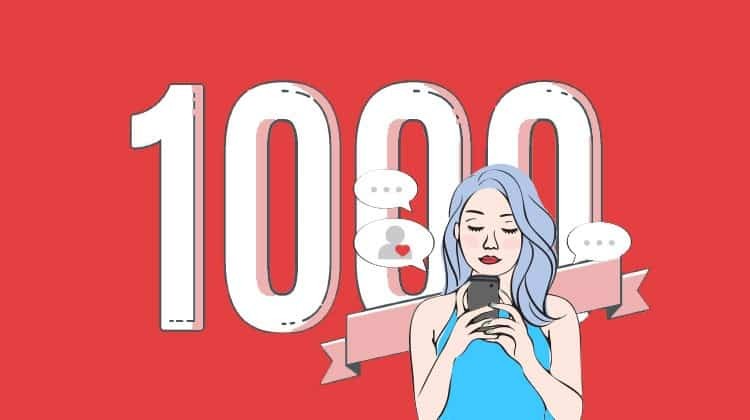Ecommerce Strategy 101: Influencer Marketing
by Cydney Hatch • March 14, 2019
Have you ever seen commercials of Jennifer Anniston selling Aveeno body lotion? If you have, I think its safe to say it’s a successful product because everyone wants to look as good as Jennifer Anniston (the woman never ages!).

Using celebrity influencers like Jennifer Anniston to help sell your products is a tried and true ecommerce strategy retailers have used countless times to build awareness and boost sales.
Now, many ecommerce brands do not have the ability to cast an A-list celebrity like Jennifer Anniston to sell their products, but they can harness a similar ecommerce strategy: influencer marketing.
Case in point, brands in 2017 turned heavily to influencers on social media to help sell their products and businesses to targeted audiences.
So, if you are looking for an ecommerce strategy you can use to grow your audience and improve sales through social media in 2018, give influencer marketing a try!
What is an Influencer?
An influencer is a person who has established credibility in a specific industry niche. A influencer can be a YouTube Channel star, blogger, industry expert, or social activist.
To take it a step further, influencer marketing is an ecommerce strategy that focuses on using these social influencers to drive your business message to a larger market instead of marketing directly to them yourself.

Instead, you hire the influencers to reach out to these people for you!
Influencer marketing often goes hand-in-hand with two other ecommerce strategies: social-media marketing and content marketing.
Since social proof spreads like wildfire through social media these days, influencers are an easy way to add fuel to the fire! Influencers have the social power to persuade their large audiences to promote, buy and follow a brand they discuss or feature on their pages.
Why Does Your Business Need Influencers?
Social proof matters to people. These days, brands have trouble developing strong trust with their targeted audiences. Nielsen reports 92% of people trust recommendations from individuals—even if they don’t know them—over brands.
That online trust equals sales for you!
Twitter reports nearly 40% of Twitter users say they’ve made a purchase as a direct result of a Tweet from an influencer. Those numbers are often even higher for Pinterest and Instagram!
People trust people, so influencer marketing is a way to build your business trust. When you align your business with an influencer, not only do they bring their loyal audience to your business, they also bring an audience that already trusts them and—by extension—you!
Influencers have the ability to drive traffic to your site, increase your social media exposure and sell your products to their “die hard” followers.
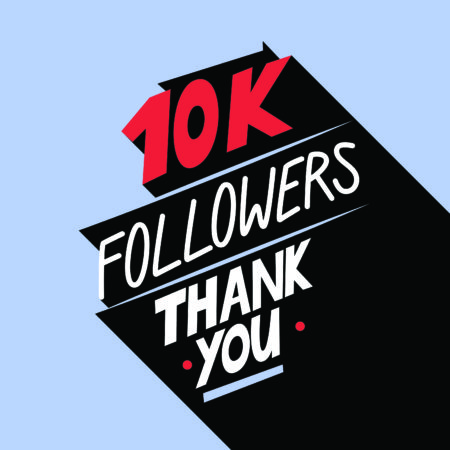
It’s a pretty powerful symbiotic relationship!
Influencer marketing is becoming one of the most effective ways to attract customers. After all, today’s consumers are a different breed from previous generations. They want to make purchasing decisions on their own, without your ads.
Instead, they want to hear about your business through someone they trust.
So, if you are looking for a powerful ecommerce strategy that will generate trust in your business, influencers might be perfect solution!
Influencer Ecommerce Strategy Basics
Now, before you pay or compensate anyone to promote your business, be sure you have a proper plan in place. When thinking about influencer marketing, you need to consider three key steps:
- Influencer Identification
- Meaningful Content & Distribution
- Performance
Throughout this process, you’ll need to know your audience, set clear goals, and define how you’ll measure success!
Influencer Identification
Once you figure out your target audience, you will need to identify the key influencers in that audience. You will need to be thoughtful with your ecommerce strategy to find the “perfect fit.”
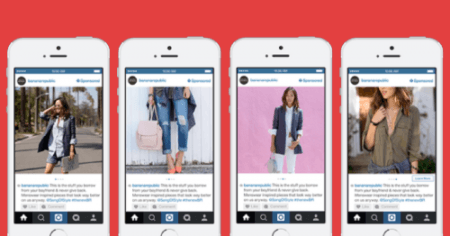
An “ideal influencer” for your ecommerce business will be one that matches your brand’s tone, style, and mission. You are not just paying someone to say “buy this”—you want someone who can create meaningful content around your business and its objectives.
On top of finding the right influencer, you will want to find one that is popular on the right platforms! Social media and blogs are the top places you should be finding influencers.
Social Media
Social media monitoring allows you to find influencers who work in the genre or niche you have outlined for your ecommerce strategy. For example, if you own a weighted blanket business, you will want to find a social media influencer that is:
- Popular in the fitness/health world
- Posts heavily about fitness products
- Partners with stores and places you would be interested in selling your product in
- Creates giveaways and promotions for followers
- Engages with fitness conferences
If you are scrolling through social media profiles, you might also want to take a look at hashtags and identify the hashtags that your target audience is using.
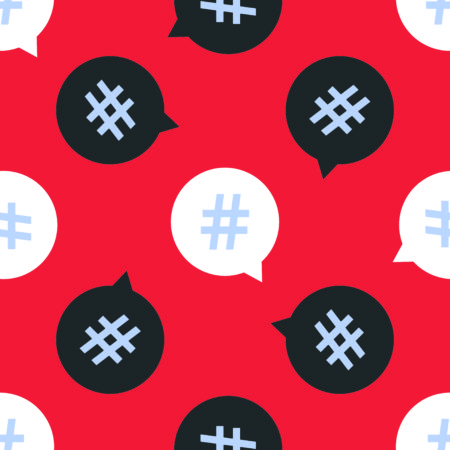
By tuning into hashtags, you can find the active influencers who are talking to your target audience.
Once you start weeding through the influencers that seem like a good fit for your brand, I recommend putting them on a list so that you can organize and follow them. Use platforms like Hootsuite and other social media following apps.
Blogs
On top of finding social media influencers, look for popular bloggers!
Bloggers arguably are some of the most popular influencers. This report from Technorati shows us that 86% of influencers also operate at least one blog. One of the bonuses of targeting bloggers is that they are also super active across many social media platforms, too.
It’s like double-dipping for exposure!
To identify influential bloggers for your brand, start by searching for blogs in your target audience. Once you’ve put together a list of potential candidates, find their niche by reading through their posts to determine if they write about relevant topics to your target audience.
After making a list of the contextually relevant bloggers, research their SEO stats and social media information to pinpoint the ones that will have the best exposure for your target audience.
Meaningful Content & Distribution
Your ecommerce strategy should be more than just having someone say “buy this now.”
A common mistake ecommerce businesses make with their influencer marketing is being too obvious. For instance, an influencer takes a photo with your product or service and writes a generic caption saying “check ’em out.”
Blah, I am bored just writing this! Please don’t do this…
The key to great influencer marketing is creating meaningful content for your audience. Content is the compelling part of your influencer marketing partnership that gets people to trust your business and buy from you.
But to pull all that off, you need great content.

Great content entertains, educates or builds a connection to your audience.
What story do you want to tell? How can you convey your message creatively? What benefit does your audience get from seeing your influencer with your brand?
Your content should be a deep, integrated part of your entire ecommerce strategy. Use influencer content in blog posts, visuals and testimonials. Feature your influencers in ads, newsletters or promotional items you will be sending out to your target audience.
How to Use Influencer Marketing for your Business
Once you have the top influencers you want and they have agreed to work with you, what then?
Influencer marketing is more than just “selling” your products or business to your target audience. To bring you up to speed, I’ve put together several ecommerce strategies you can use for your campaigns.
Instagram StoryTelling
A lot of brands and marketers automatically associate influencer marketing with Instagram and they totally should! In fact, one survey found that Instagram was the No. 1 platform for 92% of influencers in 2017.
Since Instagram is one of the main platforms you will use, it will be important to use its feature creatively to brand your business.
One of the best ways to do this is with Instagram Stories. Instagram Stories allow users to post multiple pictures and videos in a slideshow format that will disappear after 24 hours.
Brands can take advantages of this feature to improve engagement, brand awareness and post more content without overwhelming followers feed (which customers will appreciate!).
A perfect example of using Instagram Stories for influencer marketing comes from my favorite designer, Betsey Johnson!
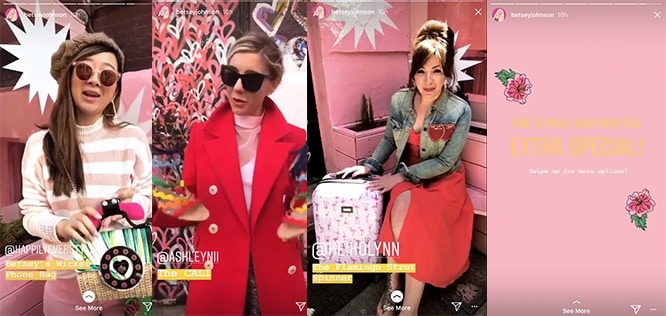
For a Mother’s Day content push, Betsey had popular fashion bloggers talk about their favorite Betsey Johnson items they would be giving their mothers for Mothers Day.
In addition to creating engaging content, Betsey carefully branded her Instagram Stories by giving the backgrounds her color palette and usinging text and visuals commonly found on her prints and site.
These posts not only talk about her products but they visually scream BETSEY JOHNSON! By having these influencers talk about her items she created social proof and gave customers a reason to buy something Betsey for their mothers.
Another example of successful Instagram Story strategy is Kylie Jenner’s lipkits specifically using Instagram story’s “Swipe Up” feature paired with promotions.
“Swipe Up” is a call-to-action feature of Instagram Stories that allows businesses to send their audience to direct links.
Kylier Jenner lipkits use this quite frequently since her lip kits fly off the shelves within hours of launching on her site.
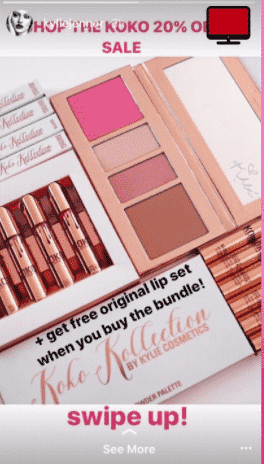
Why is this successful?
Since Instgram story content only lasts 24 hours, it creates “FOMO” or “fear of missing out.” When you use this feature with promotional codes and other sales, that “FOMO” drives people to act.
The impermanence of Instagram Stories drives action by making your audience feel that you are offering an opportunity they might miss out on if they don’t act now.
Be Transparent
As soon as anything becomes socially popular, the internet catches on…which often means more regulations, unfortunately. As you are looking to do influencer marketing, it’s good to know that transparency will matter moving forward.
To create better trust with consumers as well as dealing with FTC regulations its important you share that posts are paid posts with your consumers.
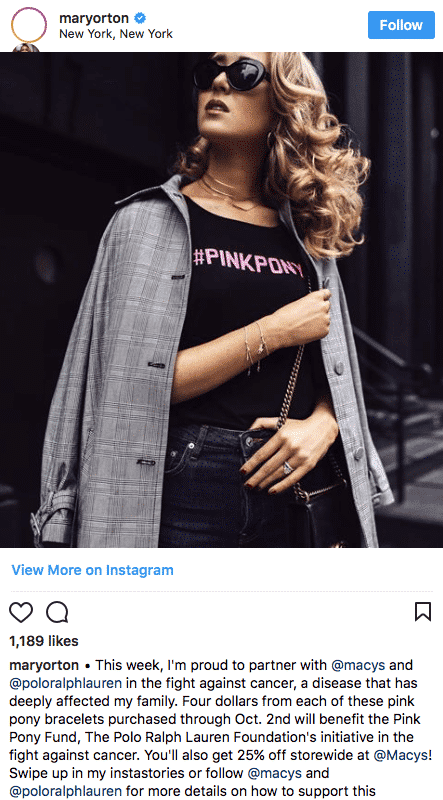
Disclose every paid piece of content you will have an influencer post. If you signed an influencer to create seven posts next month, you can’t just have them disclose that you’re working together in the first post and leave that out in the other six.
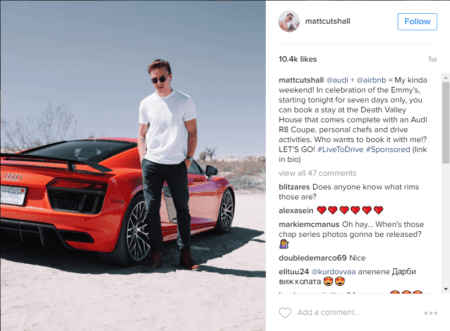
Be sure to check each paid post. Don’t assume that just because you asked the influencer to put #sponsored in their Instagram caption that they’re actually doing it.
Influencer Promo Codes
Who doesn’t love a sale?
Incentives are a great ecommerce strategy. To take it a step further, you can create specific promo codes for influencer followers to use!
For example, Taza of the “Rockstar Diaries” frequently has ecommerce businesses approaching her to share promo codes with her followers.
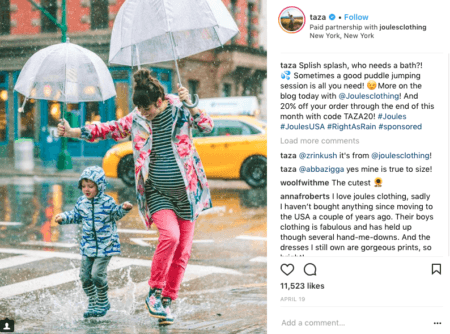
In the example above, she had a blog post (and social media posts) sharing her personal memory of dancing the the rain as a kid. She created an emotional connection to readers through her written word, but the photos of her and her son jumping in the rain are just adorable.
I mean, I want to buy these dang rain boots!


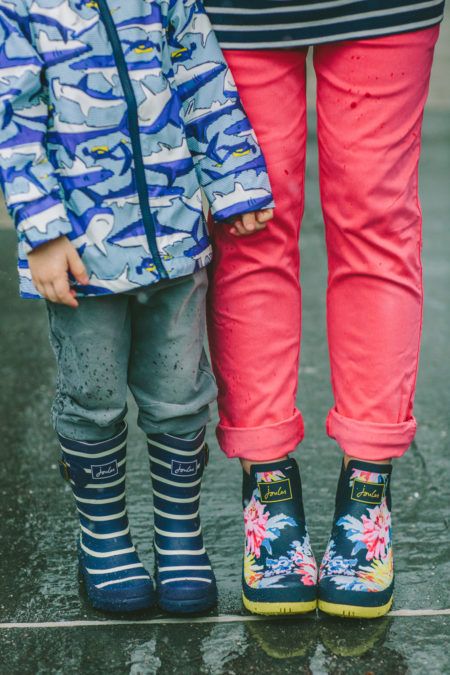
Through her content, she makes rain look adorable and fun. At the end of her post, Taza has promo codes and a thank you for Joules for sponsoring the post!
Another great and more simple approach is James Charles’s YouTube Channel
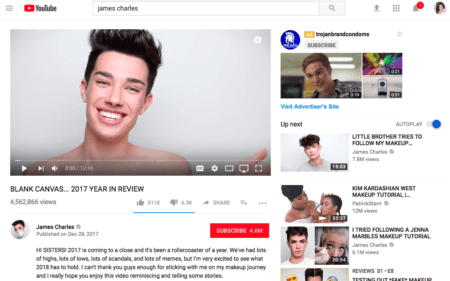
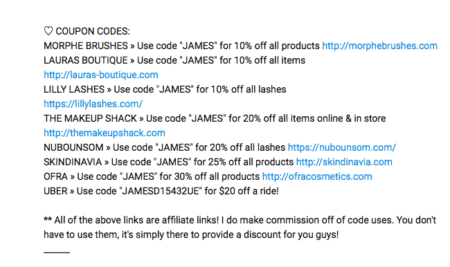
James is one of the hottest make up artists on YouTube with 4.6 million subscribers. Talk about a marketing opportunity!
As you can see above, one simple ecommerce strategy is to have promo codes permanently listed on a YouTube channel or—if your products are featured in a tutorial—list them in the video description so subscribers can easily purchase items directly on the link they share.
Create Meaningful Relationships
Nobody likes the feeling of being used, so why make your influencer feel that way? The brands that see the most success with influencer marketing are the ones that treat influencers as partners rather than a pretty pony to draw attention.
These relationships and partnerships are more than just selling your business. They are a symbiotic relationship that will only get better as you genuinely care and invest in the people you work with.
When you treat influencers like an extention of your business, it generates a sense of loyalty and trust that will be apparent in the content they create.
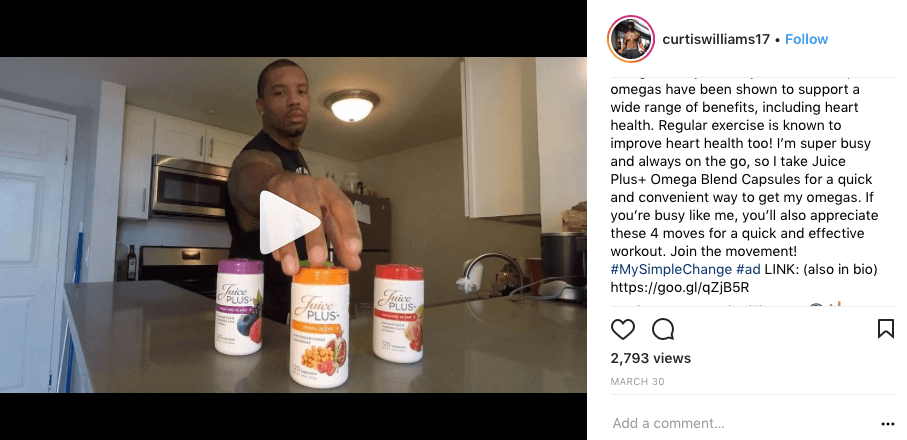
For example, in the video post above, fitness coach and former NFL player Curtis Williams shares his passion for Juice Plus products.
In the video and written content, he shares his life-changing experience and how these supplements helped him achieve benefits and goals. It’s unlikely he would share such a compelling experience if he didn’t also have a great relationship with business itself.
Visual Content
Studies show that images are one of the most important components of social media posts, so you should expect high-quality imagery from your influencers.
However, great imagery isn’t just about creating pretty photos. Your content needs to have a purpose!
Instagram has a feature called Shopping Tags which allows ecommerce marketers to tag specific products in their images. To show you how this works, let’s take a look at a post by Dazey LA who has tagged the headband, shirt and earrings in her photo:
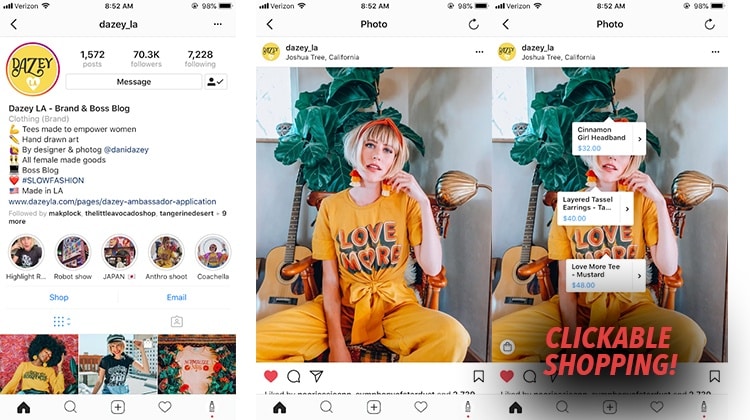
Users will see a “Tap to view products” notification in the bottom left of the image, which when tapped, reveals a set of tags that appear overlaid on the post, showing item details and prices. If they like what they see, they can click and the link will take them to a product page on the site of your choice.
Talk about a game changer!
This feature is great because it allows direct shopping on the Instagram. It’s simple and not “in your face.”
Another great thing to keep in mind is making your visual content as sharable as possible!
Visually-targeted platforms like Instagram allow you to share content, so make sure you create eye catching content that can be shared. This is particularly helpful for blog posts!
BONUS: Best Visual Paid Advertisement Opportunity!
On top of visual content, you will need visual advertisements! A great option for this is the Facebook Carousel Ad which is reported to drive 10 times more clicks than traditional ads!
Why? Well, Carousel Ads allow you to showcase up to 10 images or videos within a single ad, each with their own links!
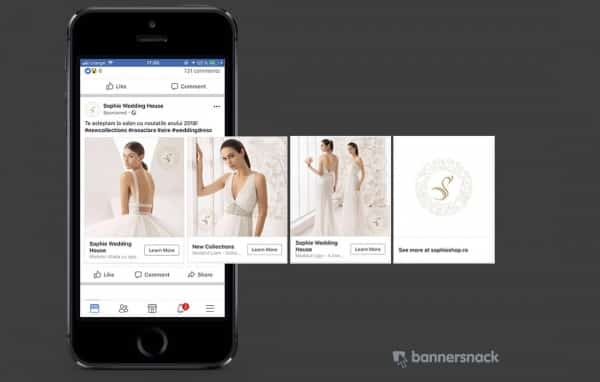
Using carousel is a creative option to highlight different products, showcase multiple items to share a sale promotion or tell a story about your brand! This is option is particularly helpful to eCommerce businesses as it optimizes visual marketing for products.
To learn more about visual ad specs and the power of visual content and advertisments click here!
Cross-Features
DesignLoveFest is one of my favorite lifestyle blogs. Bri, the founder, recently partnered up with Target to promote her furniture line.
Both parties cross-featured each other on their websites.
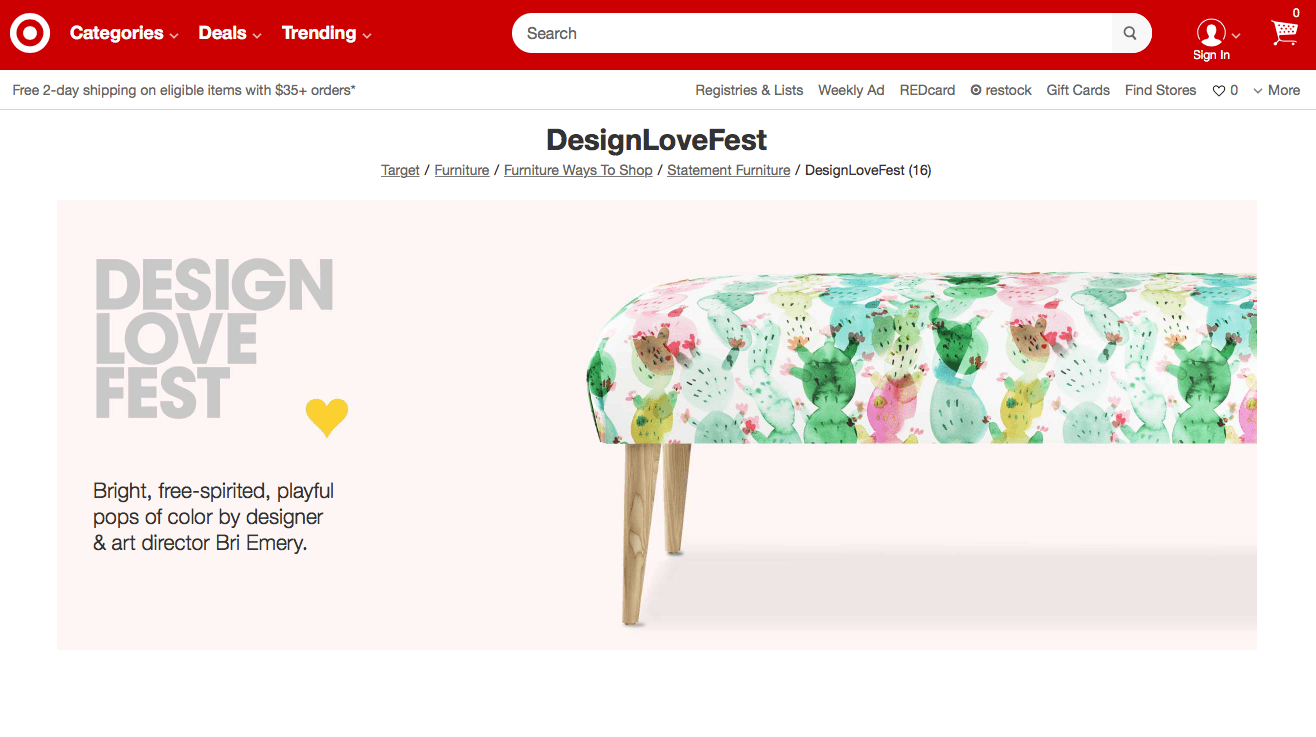
Along the same lines, if you really want to dig into meaningful partnerships, have your influncer design or create a line for your audience.
If you are selling mens ties, have a popular mens fashion blogger design patterns to print on your ties for a limited time!
On top of this partnership with Target, Bri also frequently features clothing, accessories and home goods on her “SHOP” page, which promotes the companies she buys her lifestyle products from.
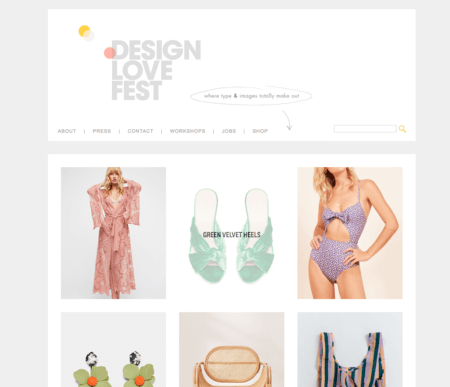
So, if I was interested in buying these green velvet shoes I saw her wearing, I can easily click on the item photo and it’ll take me to Loeffler Randal’s site where I can directly buy the product.
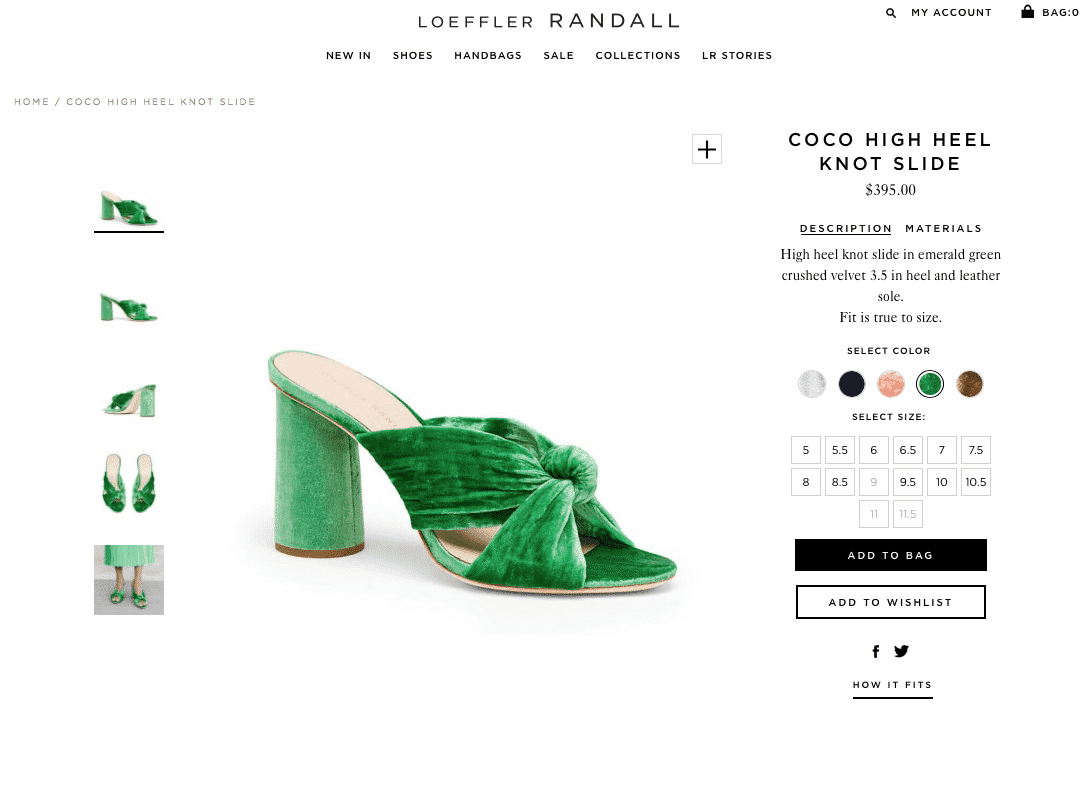
You can easily have an influencer list items you sell on their “shop” pages!
Special Hashtags
Create hashtags for your business but you can also create unique hashtags for influencer campaigns! Create or use hashtag holidays that relate to your business.
Examples of this could be: #TacoTuesdays, #SassyShoeSunday, #FitnessFridays, #MakeUpMonday, or #BlackFriday.
Alliteration is crucial in making your hashtag stick.
Video Content & Vlogs
Video is a powerful tool in ecommerce. From creating product short videos where potential customers can see how clothing “wears,” advertisements to “How To or FAQ” videos, video matters—especially if you want to reach the younger generations.
In fact, 70% of teenage YouTube subscribers say they relate to YouTube content creators more than traditional celebrities.
One way to successfully implement video with influencers is working directly with them through sponsored content, product reviews and partnership deals.
Some creative examples include:
- Blogger Vlogging: A blogger could do a fitness bootcamp program you have created and have them create a VLOG about their experience. Maybe even have them create before and after photos to show results.
- Tutorial Videos: Tutorial on using a product with them showing features and things they love about using it.
- Fashion Look Books: Have a fashion influencer wear your product and showcase it in an eyecatching video. For example, D.C. Fashion Blogger and dear friend Ella Pizoli does great visual content to showcase accessories and clothing pieces.
- Let Them Be Creative: Zach King does some quirky stuff but makes video interesting for the the viewer and brand letting them…well be them! Check out his video where he partnered up with Lifestyle blogger Taza for Target!
Contests & Giveaways
Everyone loves the feeling of winning something or just plain FREE STUFF.
Influencers hold successful giveaways to their followers which quickly draw followers to social media pages with specific calls-to-action! This tactic helps greatly with brand awareness as well as boosting numbers.
For example, the always beautiful Alexis Kaiser held a giveaway with the whimsical crib sheet company, @rookiehumans to giveaway a $100 Gift Card to a lucky winner!
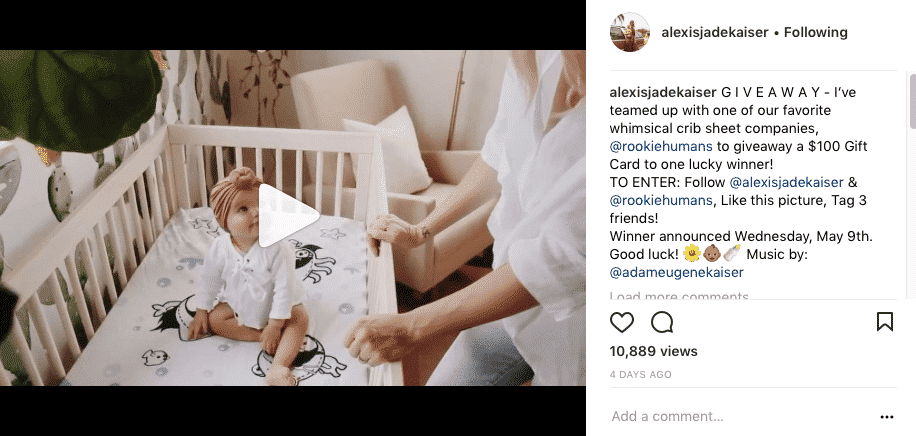
Not only did she draw customers in with an adorable short video of her daughter and the products but she had specific giveaway actions followers needed to follow to enter:
“TO ENTER: Follow @alexisjadekaiser & @rookiehumans
“Like this picture, Tag 3 friends!
“Winner announced Wednesday, May 9th. Good luck!”
This incentivizes followers to like pages which opens them up to see other products and can push new viewers to your site. This is BIG cross promotional effort brands are doing with influencers and they see great success.
Plus, its a great “you scratch my back and I will scratch yours” tactic! Who doesn’t want new followers and potential customers?
Advertisements
Although you want to stay away from having “ad-like” content with most of your influencer marketing, there are a few ways to use influencers in your actual ads.
My favorite clothing store, Modcloth, does a stellar job at not only implementing influencer marketing but creating a complete social proof experience for buyers! (yes, I do have the dress that singer/songwriter, Kate Nash is featuring below).
It is okay to use recognizable influencers in your ads!
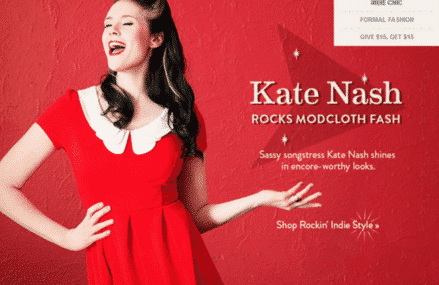
Fashion ecommerce websites use social media influencer marketing like pros! Many reach out to popular fashion bloggers and send them clothing, accessory items, and beauty products to be reviewed on their platforms. The social media influencer then posts photos and videos linking back to the site where their audience can buy the items featured.
Going back to Modcloth, they feature the blogger’s photos they send products to in their advertisements!
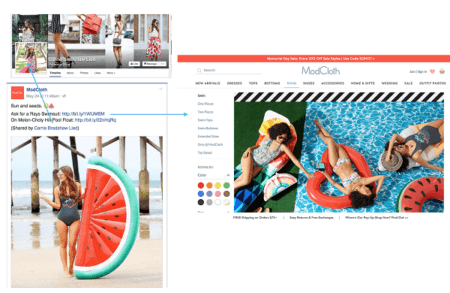
I’ve seen many fashion sites, like Modcloth, send their items to an influencer, and then the audience could enter a contest to receive it. Or sometimes they will send a credit to a fashion blogger so they can go to the site, pick out some clothing and then review the experience as a whole.
Another way Modcloth “advertises” is with “Modcloth Sightings” where bloggers, customers and influencers can share pictures of them wearing Modcloth clothing.
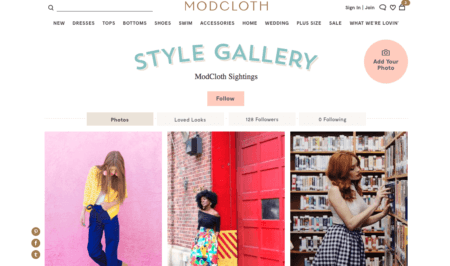
By creating this type of social platform on their site, ModCloth makes their audience feel special, which encourages social buzz about their clothing and creates a network of loyal people who are actively looking at their clothing, accessories and home items!
Measuring Performance
None of this will be worth it if you are not measuring the impact and success of your influencer marketing. Are your influencer marketing campaigns actually profitable and helping you reach your goals?
More importantly, how do you measure that?
While the monetary value is not always direct, you can still track how much revenue you are getting from their posts and actions.
One of the most basic ways to at least get started is to use URL tracking parameters. Assign specific parameters to your influencers so you can track the actions of every visitor they drive to your site.
Other metrics to measure your influencer marketing success are:
- Reach and views
- Likes/Follows
- Clicks and votes
- Brand studies
- Shares and referrals
- Tracking tags
- Comments
- Click to ecommerce pages
- Coupons/Promotional campaigns
The important thing here is to track whatever you can track. Some aspects of influencer marketing can be hard to measure, but a lot of it is very measurable and is something you should follow to make sure that you are getting value from your investment.
You are Now Under the Influence: Give It A Try!
Influencer marketing has become popular because—when done creatively, strategically and correctly—it works.
Simply paying someone with 50,000 followers to share your post on Instagram won’t help you gain the success you want. By implementing these tips and tricks, you can create more natural social interaction with your target audience which can easily convert to sales.
If you want help in implementing an influencer-based ecommerce strategy, please reach out to me in the comments! I do not bite!
What influencer marketing campaigns do you love? What do you look for in an influencer? Comment and share below!

